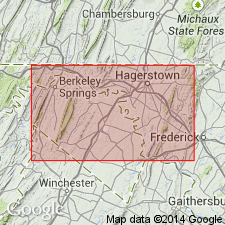
- Usage in publication:
-
- Rockdale Run formation*
- Modifications:
-
- Named
- Dominant lithology:
-
- Limestone
- Dolomite
- AAPG geologic province:
-
- Appalachian basin
Summary:
Named Rockdale Run formation of the Beekmantown group for Rockdale Run, near Hicksville, Washington Co., MD. Consists of interbedded limestones and dolomites overlying the Stonehenge limestone. The lower two-thirds of the formation is predominantly limestone, while dolomite dominates the upper third. The top of the Rockdale Run is placed at the top of the highest limestone bed beneath the Pinesburg Station dolomite. The formation averages about 2450 feet thick. A number of faunal zones may be useful for local and regional correlation including the LECANOPIRA zone (200-560 feet above base), the ARCHAEOSCYPHIA zone (560-790 feet above base), the DIPARELASMA zone (790-1420 feet above base), and the SYNTROPHOPSIS-CLELANDOCERAS zone (1650-2070 feet above base). The formation is considered of Early Ordovician age.
Source: GNU records (USGS DDS-6; Reston GNULEX).
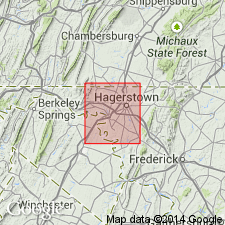
- Usage in publication:
-
- Rockdale Run formation*
- Modifications:
-
- Overview
- AAPG geologic province:
-
- Appalachian basin
Summary:
The Rockdale Run formation includes three lithologic zones, a cryptozoan chert zone confined to lower 100-200 feet of formation, a concentration of oolitic limestones about 100-200 feet thick about 200 feet above cryptozoan chert zone, and dolomite in upper third of formation. A detailed description of the type section is included.
Source: GNU records (USGS DDS-6; Reston GNULEX).
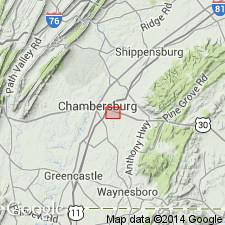
- Usage in publication:
-
- Rockdale Run formation*
- Modifications:
-
- Areal extent
- AAPG geologic province:
-
- Appalachian basin
Summary:
Geographically extended the Rockdale Run formation into south-central PA, Franklin Co., Chambersburg area and south to MD. The lithic designations and faunal zones of MD hold for the PA sections. The unit is 2547 feet thick.
Source: GNU records (USGS DDS-6; Reston GNULEX).
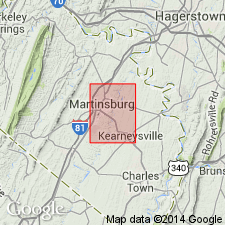
- Usage in publication:
-
- Rockdale Run formation
- Modifications:
-
- Areal extent
- AAPG geologic province:
-
- Appalachian basin
Summary:
Geographically extended the Rockdale Run Formation of the Beekmantown Group into the eastern panhandle of WV.
Source: GNU records (USGS DDS-6; Reston GNULEX).
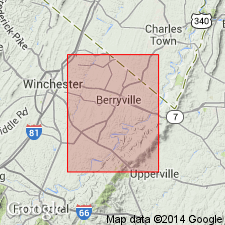
- Usage in publication:
-
- Rockdale Run Formation
- Modifications:
-
- Areal extent
- AAPG geologic province:
-
- Appalachian basin
Summary:
Geographically extended the Rockdale Run Formation of the Beekmantown Group into northern VA. Consists of blue-gray limestone and gray dolomite.
Source: GNU records (USGS DDS-6; Reston GNULEX).
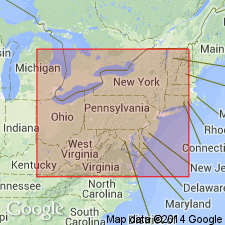
- Usage in publication:
-
- Rockdale Run Formation*
- Modifications:
-
- Age modified
- Biostratigraphic dating
- AAPG geologic province:
-
- Appalachian basin
Summary:
Conodont biostratigraphy indicates the age of the Rockdale Run Formation of the Beekmantown Group ranges from Early Ordovician (late Canadian) to Middle Ordovician (middle Whiterockian), but varies locally due to a Lower-Middle Ordovician unconformity at various places.
Source: GNU records (USGS DDS-6; Reston GNULEX).
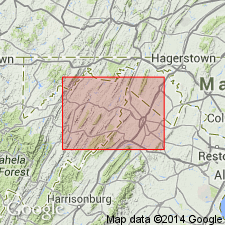
- Usage in publication:
-
- Rockdale Run Formation*
- Modifications:
-
- Biostratigraphic dating
- AAPG geologic province:
-
- Appalachian basin
Summary:
Conodont biostratigraphy indicates that the Rockdale Run Formation of the Beekmantown Group in the Winchester 30 X 60 minute quadrangle is of Early and earliest Middle Ordovician age. Conodonts from the ROSSODUS MANITOUENSIS Zone through the OEPIKODUS COMMUNIS Zone were recovered in the lower part of the formation, and conodonts from the M. FLABELLUM-T. LAEVIS to the lower H. SINUOSA Zone were recovered in the upper part in an area northeast of the Winchester quadrangle.
Source: GNU records (USGS DDS-6; Reston GNULEX).
For more information, please contact Nancy Stamm, Geologic Names Committee Secretary.
Asterisk (*) indicates published by U.S. Geological Survey authors.
"No current usage" (†) implies that a name has been abandoned or has fallen into disuse. Former usage and, if known, replacement name given in parentheses ( ).
Slash (/) indicates name conflicts with nomenclatural guidelines (CSN, 1933; ACSN, 1961, 1970; NACSN, 1983, 2005, 2021). May be explained within brackets ([ ]).

